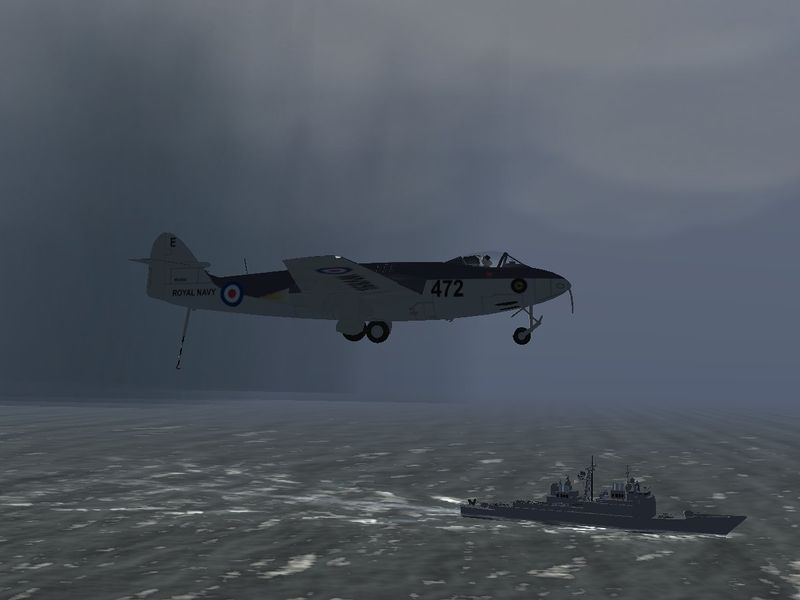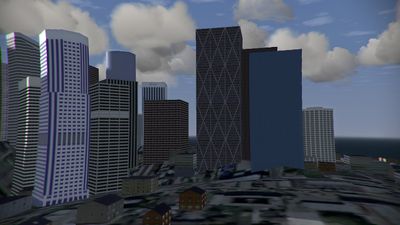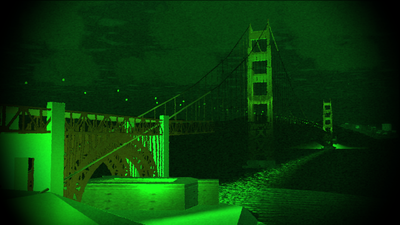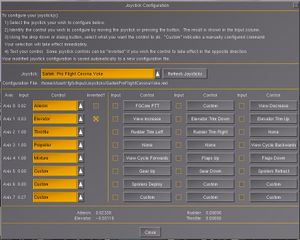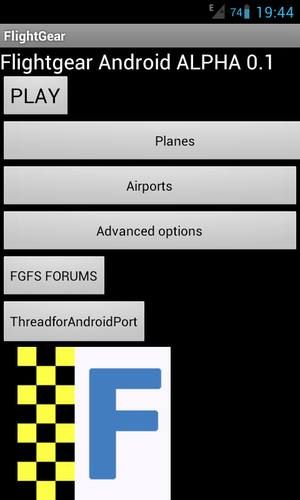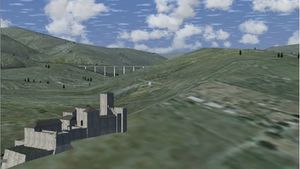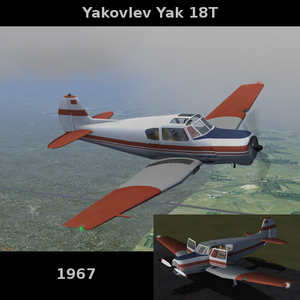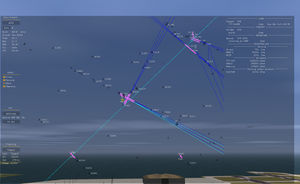FlightGear Newsletter August 2012
|
We would like to emphasize that the monthly newsletter can not live without the contributions of FlightGear users and developers. Everyone with a wiki account (free to register) can edit the newsletter and every contribution is welcome. So if you know about any FlightGear related news or projects such as for example updated scenery or aircraft, please do feel invited to add such news to the newsletter.
FlightGear 2.8.0 released!
The FlightGear team is very excited to announce the v2.8.0 Release is now available! I will be brief and simply post the link to the official release announcement.
http://www.flightgear.org/news/flightgear-v2-8-0-released/
Major improvements from v2.6.0 include improved AI aircraft, up to date with all the recent JSBSim flight dynamics model improvements, support for region specific textures, better random 3d buildings, better random object placement, 3d airport signage, in-sim toggling between summer and winter texture sets. The core FlightGear code now supports a flexible 2d rendering system which can be used to accurately model glass cockpit displays and other complex instrumentation. There are many new and improved aircraft to explore. A new automated system is now available for scenery submissions that automatically get rolled into the scenery distribution to be enjoyed by everyone. Version 2.8 has improved atmospheric light scatter modeling, better terrain haze, and improved 3d clouds.
A very exciting new addition is “Project Rembrandt”. This is still considered “experimental” and not enabled by default. But when you turn it on you will get real-time shadows, support for multiple light sources (landing lights, instrument lights, directional ground spotlights, even the rotating beacons illuminate the surrounding correctly.) In addition, Project Rembrandt offers a variety of other visual effects such as night vision, film grain effects, depth of field effects, lens (i.e. fisheye) distortion — all in real time.
For the full change log, please see the release announcement.
Enjoy!!!
15 years of FlightGear, screenshot contest
To celebrate FlightGear's 15th birthday (July 17), we decided to organise a screenshot contest. After two weeks of public voting, the winners were announced on August 18 with the release of FlightGear 2.8.0. The winning screenshots are used to promote FlightGear to the wider public.
Nearly 500 people participated in the voting. Voters were presented with two random screenshots at a time, from which they had to pick the one that they liked most. This was repeated over and over again. In the end, 41845 screenshot pairs were compared! The screenshots were then ranked according to their pass ratio. The more a screenshot was prefered over it's partner, the higher it ended up in our ranking.
The overall winner was Thorsten Renk's screenshot of a Seahawk, "Passing through a rain front during a carrier approach.", which you can find below. The complete ranking and all participating screenshots can be found at flightgear.org/contest
Interested in reading more about FlightGear's history? See FlightGear History.
Development news
A view of FlightGear core and fgdata activity in Git since the 2.6.0 release. Each committer on fg and fg-data is shown here, as well as the part of fg where he's been working on. A big thank to all involved for making FG such a nice fireworks!
Project Rembrandt
Fred's been working on some fancy new effects, especially useful for our film-making enthusiasts.
The Rembrandt renderer has a lot of potential when it comes to post processing effects. Indeed, the interesting property of a deferred shader is that all stages of rendering are kept in memory. Post-processing is as simple as using a filter on a camera.
Currently the effects added in git are :
- Night vision including amplification grain and restrained field of view,
- Cinema effect including :
- Vignetting,
- Color shift, with Sepia as default value,
- Radial distortion (barrel and pincushion distortion, with scale compensation),
- Lateral chromatic aberration (purple fringing),
- Film wear simulation.
This did not make it for the 2.8 release but it's likely that an add-on will be available as it is contained in the data.
See also :
Unified weather GUI
As most readers will be aware, FlightGear supports two weather models - Basic Weather which represents METAR data directly, and Local Weather which models weather more realistically, with more variation. In 2.8.0 these were configured separately using different UIs. Stuart Buchanan and Thorsten Renk have been working on unifying the user interfaces to provide a more user-friendly and consistent interface. This work is now available in git.
Joystick configuration GUI
A further usability enhancement has been made by Stuart Buchanan to allow configuration of joysticks through a GUI in-sim. Instead of configuring a joystick using XML, users can now change joystick bindings within the simulator - no XML knowledge required. The updated joystick configuration takes effect immediately. This work is also available in git, and should make it much easier for new users (or those with joysticks unknown to FlightGear) to get flying.
Canvas news
As of August, the new Canvas 2D drawing system in FlightGear HEAD has now also support for:
- using raster images (vector images were already supported previously)
- nested canvases, where a canvas may contain images created by another canvas texture Howto:Using raster images and nested canvases
- creating GUI windows (not just widgets)
- handling GUI events using osgGA
- multiplatfom copy/paste support using two new Nasal functions: Howto:Clipboard access using Nasal
Support for nested canvases will make it possible to also load canvas textures into other canvases, so that you can, for example, easily load an instrument into a GUI dialog, or even use GUI widgets in MFD instruments, which is a feature based on real avionics, i.e. as used in modern airliners like the A320 or the 787.
Nested canvases also make it possible for people to easily implement GUI tools using the Canvas system, for example a GUI instrument or panel editor can be entirely implemented in scripting space now, without touching any C++ code. Similarly, GUI widgets could also be created in a WYSIWYG-fashion, too - so that even dialog editor or full GUI builders can be built using the Canvas system.
In addition, Tom has now implemented support for window stacking. Check out the demo video below, which demonstrates how "nested" canvases and window stacking works:
Also, Tom is currently working on an improved event handling system with support for event-propagation based on the Javascript/DOM model. The event handling systems requires close interaction between the core system and Nasal code. Event propagation and bubbling will be supported like in the W3C DOM standard. We need eg. to be able to mark an event as handled and maybe also other things which change the behavior of the propagation.
In addition, Tom has started work on some building blocks to provide basic inheritance support for canvas properties, so that styling (CSS/XSL) will be much easier.
Missing features, and features currently under development, are listed at Missing Canvas Features
FlightGear Run-Levels
Recently, there was talk on the FlightGear developers mailing about implementing a standalone FGCanvas client, analogous to FGPanel - in order to be able to render Canvas instruments separately, in different processes and also on different computers.
However, obviously this new startup mode would not need many of the default subsystems, such as the FDM, sound, terrain etc. This requirement is shared with the Flightgear On Android project. But, many of these default subsystems are initialized in a hard coded fashion so that they cannot currently be made optional even though they may not be stricly required. Also, for a very long time, it's never been possible to fully reset FlightGear properly, this makes many things very difficult or even impossible, including the FGCanvas idea.
Hooray and TheTom have now started collecting ideas on how this could be changed, by making subsystem initialization more explicit using listeners, so that SGSubsystems can be dynamically allocated and freed based on setting signal properties, so that recursive run levels can be implemented. For more information, please see FlightGear Run Levels. Feedback welcome!
FlightGear On Android
A new developer has achieved a way to run FlightGear on Android (FOA) phones. He has done a lot of Android and C++ coding. His phone is a Samsung Galaxy Nexus and is running Android 4.04 (custom ROM but stock ROM should be OK). If your ready to test with us, please read the technical info then send a email to lacbrc@gmail.com!
TECHNICAL INFO: It should have at least a 1GHz processor and decent graphics chip. Android 2.3 is a must but a rooted device is not needed but can improve performance. Not much in this, as we haven't finished it to a release yet. He tested it on a bluetooth keyboard and a wired one through usb host mode. Hope you are interested in it!
The first ALPHA release is fresh out of its release, and you can read more at the forum ![]() .
.
The FlightGear for Android Team
Getting involved as a programmer
Please see Howto:Start core development
Translators required
| The FlightGear Wiki still needs help for translating it into various languages. If you are interested in making the FlightGear Wiki multi-language then start at Help:Translate. | |
| Das FlightGear Wiki benötigt immer noch Hilfe bei der Übersetzung in verschiedene Sprachen. Wenn Du Interesse daran hast, das FlightGear Wiki Mehrsprachig zu machen, dann fang doch mit Help:Übersetzen an. | |
| De FlightGear Wiki kan nog steed hulp gebruiken bij het vertalen van artikelen. Als je interesse hebt om de wiki meertalig te maken, raden we je aan om een kijkje te nemen bij Help:Vertalen. |
Interview with a contributor
In each edition we have an interview with a contributor. Suggestions for possible questions are available on interview questions, you are invited to come up with new questions and interview ideas obviously! Anyone is free to write an interview (with him-/herself or others) for next month's newsletter! If you'd like to help interview a contributor or get interviewed, please do consider adding yourself to the list of interview volunteers! To keep this going and less awkward, we are currently trying to come up with the convention that former interviewees become next month's interviewers.
Unfortunately, we didn't find and interview candidate in August 2012.
In the hangar
All the way back in May 2011, we addopted a new status-rating system for aircraft. So far, only a few have actually been rated, as can be seen in the list 'hockenberry' set up at Google Docs. If you're an aircraft developer and your aircraft is/are not on the list, please consider rating their status. All you'll need to know/do is described at Formalizing Aircraft Status. If you'd just like to get started contributing to FlightGear, this would also seem like an excellent way to get started.
New aircraft
Yakovlev Yak 18T
At the request by a new user of FG, Helijah has created and made available the Yakovlev Yak 18T in his hangar and GIT.
ATC-FS
The Air Traffic Control tool ATC-FS got an update. The old radar screen was replaced by a radar screen, which can display fixes, navaids and ILS localizers. This new radar is resizable, so you can use your big screen more efficiently.
The next version is already being worked on, it will re-implement ATC-FS using the new Canvas system (scheduled for FG 3.0) so that a fully custom drawn radar screen can be created in scripting space, including custom GUI widgets (e.g. for flight strips) - without depending on any hard coded instruments or dialogs any longer.
This new design will eventually even make it possible to reuse ATC-FS for other purposes, or even include it in an AWACS aircraft that is multiplayer-enabled.
Mil Mi-6
The big old russian helicopter Mil Mi-6 from the Mil design bureau has received a new update. More than a year after the last update a new structure of the Models subfolder allows new instruments to be added much more easily. Also, the electrical system has been revisited and new instruments have been added to the engineer panels. Please keep in mind that this still is a very early development version and therefore a lot of work still needs to be done. It is available from its gitorious-page.
Scenery corner
3D models import webform
The webform to import 3D models directly into the database is in production. Now you can use this tool to send your models to the database which is used by TerraSync. If everything is fine and your model respects the specifications written in the foreword, then it will quickly be shipped to all FlightGear users worldwide through TerraSync. Yet another unique feature amongst the flight simulation world held by FlightGear. Thanks to Clément, Julien and Martin, for their help and support, and all of FlightGear users who showed interest and support in those tools.
Already 100 3D models have been imported with this form in Shanghai, Berlin, Stuttgart, France and in the UK! See the new statistics page here. Thanks to Gijs for the new nice layout and newly introduced "object density" numbers (number of objects per 10,000 square kilomter per country).
With all the forms now working on the scenemodels website, remember you can:
- add a single object (if you only have one!!). Check here!
- update an object (for instance, a lot of power pylons are in fact communication pylons). It's here!
- delete an object (if it does not exist any more in real life). It's here!
- run a mass object positions import (if you added a lot of objets in one place). It's here!
- add 3D models you created to have them imported into FG scenery via Terrasync. It's here: they can be specific to a city (for instance: the Eiffel tower), that's what is called 'static' in the FG world, or 'shared' (a new windturbine model, for instance).
Please read carefully the various forewords on the site:
- all data imported has to comply with the GNU/GPL license ;
- you must use the elevation format used by Terrasync to give your objects/models elevation, and an offset if necessary, or they could be floating/sunk for most of users.
We hope to see a lot of scenes not yet available via Terrasync merge into scenemodels. Nothing is now easier, especially when used in conjunction with our Mapserver! Remember that this is the strength of FG compared to other sims: everything can be in Terrasync and no need to download patches or sceneries here and there.
Moreover, an AC3D viewer by Juan Mellado is also available for general public for those whose browser supports WebGL (such as Firefox)!
Scenemodels cleanup and update
A big cleanup has been done on our scenemodels database. A few thousands of duplicate objects have been removed (they were caused by mass insertion of navigation data, essentially). Nothing urgent but this makes the data in Terrasync lighter and more coherent. A script has also been launched to update the country associated with each object. While not perfect, now a lot more objects have a country!
Suggested flights
The US state of Idaho is known for its remote airstrips in mountainous terrain. The Idaho Airstrip Network has details on many of them, including airstrip diagrams.
At this time of year, it's important to take into account the temperature and altitude of the airstrips, as they combine to sap the power and lift from GA aircraft. AVWeb recently highlighted the (non-fatal) crash of a Stinson 108, which included a video taken by one of the passengers. Though the NTSB has only produced a preliminary report, it was notable that the aircraft was taking off from a grass airstrip at high altitude on a hot day and appears from the video to struggle to get airborne. The Stinson is broadly similar in performance to the c172p in our base package, and the airstrip (Bruce Meadows Airport, Idaho - U63) exists in our scenery. Those interested can try taking off using the c172p with 4 people on board (2400lbs max gross weight) and high temperatures. McCall Municipal Airport (KMYL) is 44nm away, and a good destination.
Community news
FlightGear on YouTube
Lukea made a short promo for the release of FlightGear 2.8
New tutorials and screencasts
And finally ...
Did you know?
Did you know that the FlightGear project dates back to a discussion among a group of net citizens in 1996 resulting in a proposal written by David Murr? The original proposal is still available from the FlightGear website and can be found on the FlightGear website. Read it, you'll learn a lot about FlightGears' roots which still lead the project spirit.
Contributing
One of the regular thoughts expressed on the FlightGear forums is "I'd like to contribute but I don't know how to program, and I don't have the time". Unfortunately, there is a common mis-conception that contributing requires programming and lots of free time. In fact, there are a huge range of ways to contribute to the project without needing to write code or spending days working on something.
For ideas on starting to contribute to FlightGear, you may want to check out: Volunteer.
Call for volunteers
- The FOA Team is looking for testers.
- The Target4Today project is looking for volunteers to help improving FlightGear's combat support
- The FGX launcher project is looking for volunteers
- The OpenRadar project is looking for a new maintainer.
- The FGFSPM (FlightGear Package Manager) is looking for a new maintainer.

